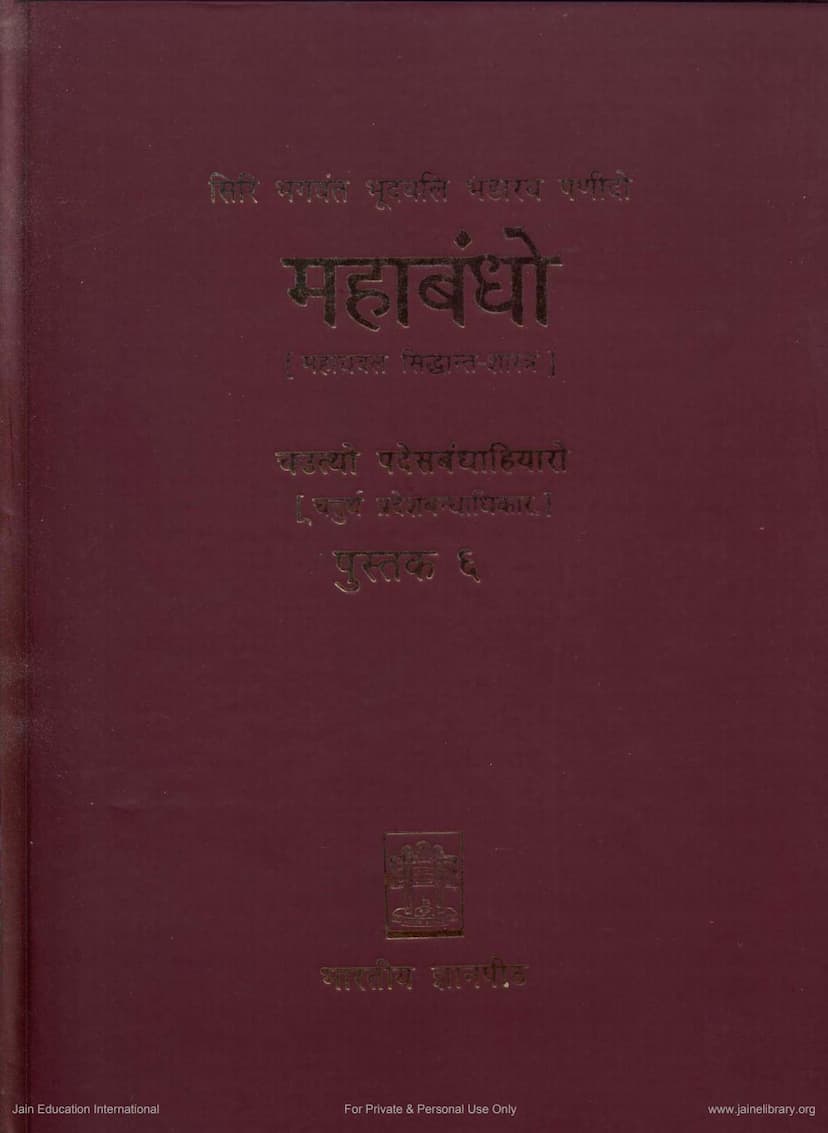Mahabandho Part 6
Added to library: September 2, 2025

Summary
Mahabandho Part 6: A Comprehensive Summary
This volume, the sixth installment of the Mahabandho (Mahadhavala Siddhantashastra) by Bhagavanta Bhutbali, edited and translated by Pt. Phoolchandra Siddhantashastri, focuses on the Pradesha Bandhadhikara (Chapter on the Binding of Karmic Particles), specifically the fourth section. It delves into the intricacies of karmic bondage, particularly the quantitative aspect of the particles of various karmas that bind to the soul at each moment.
Key Themes and Content:
The volume meticulously analyzes the Pradesha Bandha (binding of karmic particles) from various perspectives, building upon the previous volumes that covered Prakriti (nature), Sthiti (duration), and Anubhaga (intensity) of karmic bondage. The core of this volume lies in the detailed examination of Pradesha Bandha, exploring:
-
Bhagabhaga Samudahara (Distribution of Karmic Particles):
- It begins by explaining how the total available karmic particles are distributed among the eight types of karmas when they bind to the soul.
- It details the relative proportions received by Ayukarma (life-span karma), Namakarma (name karma), Gotrakarma (lineage karma), Jnanavaraniya (knowledge-obscuring karma), Darshanavaraniya (perception-obscuring karma), Antaraya (obstruction karma), Mohaniya (delusion karma), and Vedaniya (feeling karma), explaining the reasons for these differences based on their respective sthiti (duration) and nature.
- It further elaborates on how these primary divisions are further distributed among the Uttara Prakritis (sub-categories of karmas), specifying which subtler karmas receive which portions and why. This includes detailed analyses of the distribution within Jnanavaraniya, Darshanavaraniya, Mohaniya, and other karmic streams.
- The text emphasizes the concept of Sarvaghanti (completely destroying) and Deshaghanti (partially destroying) substances and their distribution, noting a difference in interpretation compared to some Shvetambara texts.
-
Twenty-four Anuyogadvaras (Categories of Inquiry): Following the distribution analysis, the text systematically explores twenty-four categories of inquiry that are crucial for understanding the nuances of Pradesha Bandha. These include:
- Sthanapranipana (Description of States): This covers both Yogasthana Pranipana (states of activity/yoga) and Pradesha Bandha Sthana Pranipana (states of karmic particle bondage). It explains the concept of yoga as the fluctuation of soul-states due to the interaction of the soul's inherent energy (Virya) with mind, speech, and body, and how these fluctuations create different "yoga places" or states. It details the subdivision of these states through concepts like Avibhaga Pratichheda (indivisible parts of yoga), Vargana (groups of Avibhaga Pratichhedas), Spardhaka (groups of Varganas), and the interval between them.
- Sarva Bandha and No-Sarva Bandha (Universal and Non-Universal Bondage): This section discusses when the bondage of karmic particles is universal (affecting all soul-particles) and when it is partial.
- Utkrushta and Anutkrushta Bandha (Supreme and Non-Supreme Bondage): This categorizes the bondage based on the intensity of particles bound, distinguishing between the highest possible intensity and lesser intensities.
- Jaghanya and Ajaghanya Bandha (Minimum and Non-Minimum Bondage): This deals with the minimum and non-minimum binding of karmic particles.
- Sadi, Anadi, Dhruva, and Adhruva Bandha (Bondage with Beginning, Without Beginning, Eternal, and Non-Eternal Bondage): This explores the temporal nature of karmic bondage, classifying it into these categories.
- Swamitva Pranipana (Ownership): It identifies which types of souls, at what stages of spiritual development (Gunasthana), are the owners of the supreme and minimum bondage of various karmas and their sub-categories.
- Kalapranipana (Time): This section discusses the duration of these various types of bondage, including minimum and maximum times.
- Antara Pranipana (Interval): It analyzes the intervals between different types of karmic bondage.
- Nana Jivanki Apeksha Bhanga Vichaya (Analysis of States considering Multiple Souls): This explores how the states of bondage vary when considering multiple souls simultaneously.
- Bhagabhaga Pranipana (Distribution of Particles): This reiterates and further details the distribution of particles based on various factors.
- Parimana Pranipana (Quantity): This deals with the specific quantities of karmic particles involved in different types of bondage.
- Kshetra Pranipana (Area/Space): It discusses the spatial extent of karmic bondage.
- Sparshan Pranipana (Touch/Contact): This explores the concept of how karmic particles "touch" or affect the soul.
- Bhava Pranipana (State of Being): This examines the psychological or existential states associated with karmic bondage.
- Alpabahutva Pranipana (Relativity of Quantity): This compares the quantities of various karmic elements in relation to each other.
-
Bhugar Bandha (Continuous or Increasing Bondage): The text then moves to explain the concepts of Bhugar (increasing), Alpatara (decreasing), Avasthita (unchanging), and Avaktavya (unmanifested) types of bondage, elaborating on their specific meanings and contexts within the framework of Pradesha Bandha.
-
Padaniskepa (Placement of Terms): This section further dissects these concepts by analyzing their Samutkirana (elucidation), Swamitva (ownership), and Alpabahutva (comparative quantity).
-
Vriddhi Bandha (Increasing Bondage): This continues the discussion on the types of bondage, specifically focusing on growth and decline in karmic particle accumulation.
-
Adhyavasana Samudahara (States of Consciousness): This section explores the states of consciousness and their role in karmic bondage, examining their quantity and relative proportions.
-
Jiva Samudahara (States of the Soul): Finally, it analyzes the states of the soul in relation to karmic bondage, again looking at quantities and comparisons.
Editorial and Translation Aspects:
The volume is presented with a Hindi translation alongside the original Prakrit text. The editors and publishers, Bharatiya Jnanpith, emphasize the critical nature of this work in the field of Jain literature. The text highlights the challenges faced in this endeavor, including the reliance on manuscript copies (like the copper plate manuscript) and the limitations due to the unavailability of original palm-leaf manuscripts, which led to some gaps and editorial decisions marked with brackets [ ].
Significance:
Mahabandho Part 6 is a crucial text for understanding the complex doctrine of karma in Jainism, particularly the quantitative aspect of karmic particles. Its detailed analysis of Pradesha Bandha, through the framework of the twenty-four Anuyogadvaras and subsequent related concepts, provides a deep insight into the mechanism of soul-transformation according to Jain philosophy. The scholarly editing and translation by Pt. Phoolchandra Siddhantashastri make this profound work accessible to a wider audience of students and scholars of Jainism.